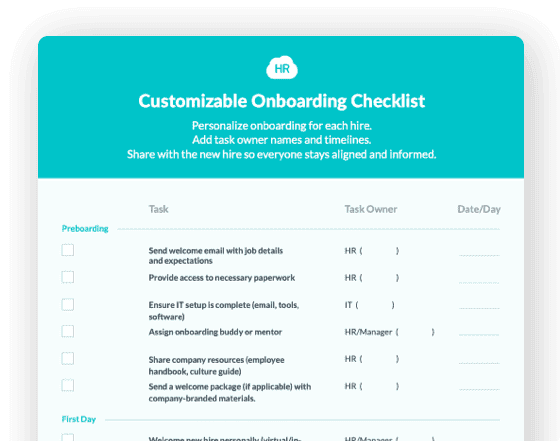Base Pay and Gross Pay
- Understanding the Core Components of Employee Compensation
- Comparing Base Pay and Gross Pay Side by Side
- Building a Strong Compensation Management Practice
- Common Compensation Mistakes to Avoid
- How Different Industries Apply These Compensation Concepts
- Creating Your Compensation Implementation Roadmap
- Preparing for the Future of Compensation Management

 Cut onboarding time
by 60%—here's the
Ultimate Checklist
that helped do it.
Cut onboarding time
by 60%—here's the
Ultimate Checklist
that helped do it.

Understanding the difference between base pay and gross pay is critical for both employers and employees. These terms form the foundation of every compensation conversation, from job offers to annual reviews. Base pay represents your fixed rate of compensation, while gross pay includes everything you earn before deductions. Knowing this distinction helps you budget better, negotiate smarter, and build stronger financial plans. For HR professionals, this knowledge ensures accurate payroll processing, transparent communication, and compliant compensation practices.
Many people use these terms interchangeably, but they describe different aspects of compensation. Base pay is what you agree to when you accept a job, the guaranteed amount that appears in your offer letter. Gross pay is what shows up on your paycheck before taxes and deductions come out. This difference matters during salary negotiations, performance reviews, and when you are planning major financial decisions. Understanding both terms empowers you to evaluate job offers accurately and advocate for fair compensation throughout your career.
Understanding the Core Components of Employee Compensation
Base pay and gross pay work together to form your total earnings, but each serves a distinct purpose in your compensation structure. Base pay acts as your compensation floor, the minimum you will earn regardless of performance bonuses or overtime hours. This fixed amount provides financial stability and serves as the foundation for calculating benefits, retirement contributions, and other compensation elements.
-
Base pay remains constant throughout the year unless you receive a raise, promotion, or role change that adjusts your compensation structure.
-
Gross pay fluctuates each pay period based on additional earnings like overtime, commissions, bonuses, or other variable compensation elements.
-
Your base pay determines eligibility for many benefits programs, including health insurance premiums and retirement plan contributions that calculate based on this fixed amount.
-
Employee records track both figures separately to ensure accurate reporting for tax purposes and compliance requirements.
-
Organizations use base pay as the primary metric when conducting market comparisons and ensuring internal pay equity across similar roles.
-
According to Indeed's compensation research, understanding these distinctions helps employees make informed financial decisions throughout their careers.
Comparing Base Pay and Gross Pay Side by Side
|
Component |
Base Pay |
Gross Pay |
|
Definition |
Fixed compensation rate agreed upon at hire |
Total earnings before deductions |
|
Includes |
Salary or hourly wage only |
Base pay plus bonuses, overtime, commissions, tips |
|
Stability |
Consistent every pay period |
Varies based on additional earnings |
|
Negotiation |
Primary focus during job offers |
Result of base pay plus performance |
|
Benefits Calculation |
Foundation for insurance and retirement |
Not typically used for benefits |
|
Tax Reporting |
Part of annual compensation |
Full amount reported on W-2 |
Building a Strong Compensation Management Practice
Managing compensation effectively requires clear policies and consistent application across your organization. Start by establishing transparent salary ranges for each position based on market research from authoritative sources like SHRM and competitive analysis. This foundation ensures you attract talent while maintaining internal equity.
-
Document your compensation philosophy clearly, explaining how you determine base pay rates and what factors influence total gross pay calculations.
-
Use comprehensive HRIS systems to track both base and gross pay accurately, ensuring compliance with wage and hour regulations.
-
Communicate compensation structures transparently during the hiring process, helping candidates understand both their guaranteed base pay and potential total earnings.
-
Review and update salary ranges annually to stay competitive with market rates, accounting for cost of living adjustments and industry trends.
-
Train managers to discuss compensation effectively, ensuring they can explain the difference between base pay guarantees and variable gross pay components.
-
Integrate payroll systems seamlessly to automate calculations and reduce errors in both base and gross pay processing.


Common Compensation Mistakes to Avoid
Many organizations struggle with compensation clarity, leading to confusion and potential compliance issues. The most frequent mistake involves misrepresenting total compensation during recruitment. Promising candidates high gross pay figures without clearly stating the guaranteed base pay creates disappointment when reality does not match expectations. This undermines trust from day one and increases early turnover.
-
Confusing base pay with total compensation during salary negotiations leads to misaligned expectations and dissatisfied new hires who feel misled.
-
Failing to update employee onboarding documents with clear base pay information creates confusion about guaranteed versus variable compensation.
-
Calculating overtime incorrectly by using gross pay instead of base hourly rate results in overpayment or underpayment and potential legal violations.
-
Not communicating how bonuses and commissions add to base pay leaves employees unclear about their total earning potential and compensation structure.
-
Ignoring regional cost of living differences when setting base pay creates equity issues and makes it harder to attract talent in expensive markets.
How Different Industries Apply These Compensation Concepts
In healthcare, organizations often structure compensation with a clear base salary plus shift differentials and overtime opportunities. A registered nurse might have a $75,000 annual base salary, but gross pay could reach $95,000 when including night shift premiums, weekend differentials, and overtime hours during busy periods. This structure provides stability while rewarding flexibility and additional contributions.
Manufacturing environments typically feature hourly base pay rates with significant overtime potential during peak production periods. A production supervisor with a $28 hourly base rate might see gross pay increase substantially during busy quarters when overtime becomes necessary. Companies use time tracking systems integrated with HR software platforms to calculate these additional earnings accurately while maintaining compliance with labor regulations.
Technology companies often use a different approach, offering competitive base salaries with performance bonuses, stock options, and commission structures for sales roles. A software sales representative might receive $80,000 in base pay but achieve $150,000 in gross pay through commission earnings. This model motivates performance while providing a financial safety net through guaranteed base compensation.
Creating Your Compensation Implementation Roadmap
Start by conducting a comprehensive audit of your current compensation structure. Review every position to document current base pay rates and analyze how gross pay varies across your organization. This baseline assessment helps identify inconsistencies and ensures you understand your starting point before making changes.
Next, establish clear salary ranges for each role using market data and internal equity analysis. Define the minimum, midpoint, and maximum base pay for each position based on job responsibilities, required experience, and market competitiveness. SHRM's compensation toolkit provides frameworks for building these structures systematically.
Develop transparent communication materials that explain your compensation philosophy to all employees. Create simple guides that show how base pay works, what factors influence gross pay, and how employees can increase both through performance and career advancement. Train your management team to discuss compensation confidently and consistently.
Implement regular review cycles to keep your compensation competitive. Schedule annual market reviews to adjust base pay ranges as needed, and conduct quarterly audits of gross pay patterns to identify trends or potential issues. Use data analytics to spot inequities early and address them proactively.
Finally, integrate your compensation management with your core HR systems to automate calculations and maintain accuracy. This integration ensures every paycheck reflects correct base pay and accurately captures all elements of gross pay, from overtime to bonuses.
Preparing for the Future of Compensation Management
The workplace continues evolving rapidly, and compensation practices must adapt accordingly. Pay transparency laws are expanding across states and countries, requiring organizations to disclose salary ranges in job postings and maintain clear documentation of how they determine base pay rates. This shift toward transparency builds trust but requires robust systems and consistent policies.
Automation and artificial intelligence are transforming how organizations manage compensation. Advanced analytics help companies benchmark base pay against real-time market data, while automated systems calculate gross pay with greater accuracy and speed. These technologies reduce administrative burden and minimize errors, allowing HR teams to focus on strategic compensation planning rather than manual calculations.
The rise of flexible work arrangements is changing how companies structure compensation. Remote work enables organizations to hire talent across geographic regions, creating new challenges for setting base pay rates that account for different cost of living factors. Progressive companies are developing location-based compensation models that adjust base pay while maintaining internal equity and external competitiveness.
Total rewards strategies are becoming more holistic, moving beyond simple base pay and gross pay calculations. Organizations now emphasize the complete value proposition, including benefits, professional development opportunities, work-life balance, and career growth potential. While base pay remains the foundation, candidates increasingly evaluate opportunities based on comprehensive total rewards packages that extend far beyond the numbers on a paycheck.
Preparing for these changes means investing in flexible compensation systems, maintaining current market knowledge, and building a culture of transparency around pay decisions. Organizations that master the fundamentals of base pay and gross pay management today will be better positioned to adapt to whatever compensation trends emerge tomorrow.
 Discover how our HR solutions streamline onboarding, boost employee engagement, and simplify HR management
Discover how our HR solutions streamline onboarding, boost employee engagement, and simplify HR management
Keep Reading
From Manual to Automated: A Complete Guide to Digitizing Employee Onboarding for Large Organizations
Sarah Chen, Director of HR at a 7,000-employee healthcare organization, starts her Monday
Enterprise HR Software in 2025: Why Traditional Enterprise Platforms Fall Short and What Actually Works
Traditional enterprise human resources software systems promise comprehensive solutions
AI in Onboarding: Complete Guide for 2026
You’ve probably been hearing this multiple times a day — AI is transforming HR. But
Ready to streamline your onboarding process?
Book a demo today and see how HR Cloud can help you create an exceptional experience for your new employees.

